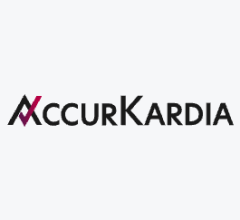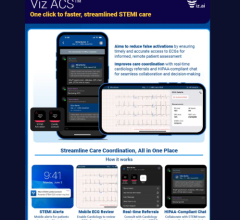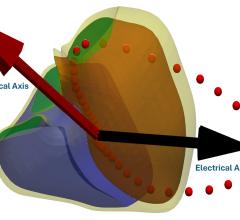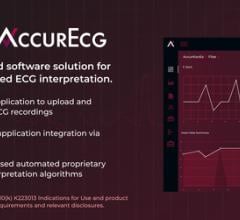
Cardiac Science HeartCentrix ECG is an example of connectivity software to enable ECG data transfers directly into electronmic medical records. The HeartCentrix allows transfers from Burdick and Quinton brand ECG devices, cardiac stress, and Holters.
According to the American Heart Association (AHA), arrhythmias afflict more than 4 million patients and results in approximately half a million deaths each year in the United States. Electrocardiography (ECG) measurements, which record and interpret cardiac electrical activity over time, are widely used to detect abnormal heart rhythms. Consequently, ECG interpretation is the best way to measure and diagnose arrhythmia, particularly conditions arising from damage to the conductive tissue that transmits electrical signals in the heart. Following myocardial infarction, an ECG can identify damage to heart muscles in some areas.
As a diagnostic tool, ECG had been around for a long time, and penetration of these systems in hospitals is very high. Despite its established nature, the market continues to evolve with new devices, including ECG monitoring systems at healthcare facilities; event monitors for subacute patient monitoring, which patients carry with them to record heart rhythm for short periods of time; implantable loop recorders that are surgically inserted into patients and can record heart rhythms for an extended period of time; and telemetry and ECG data management solutions.
The need to observe patients for an extended period of time, while ensuring accuracy and increasing compliance, resulted in the adoption of homebound outpatient telemetry services for post-coronary artery bypass graft (CABG), atrial fibrillation, and drug management for patients. Although these systems provide beat-by-beat recording and analysis and can store data for up to 24 hours, they suffer from one significant disadvantage – the patient has to be home-bound, as these systems do not have cellular capabilities and can not monitor patients when they are separated from the hardware installed in their homes. Mobile cardiac outpatient telemetry (MCOT) solutions overcome these handicaps by incorporating cellular capabilities, and are the latest evolution in the telemetry market for ECG devices.
Because of increased patient compliance, enhanced care, and improved detection rates, adoption of MCOT in the U.S. market has shown explosive growth. In 2008, CardioNet — the market leader in this segment – more than doubled its revenues from its MCOT services. The enhanced functionality of MCOT devices and continued innovation in this segment, such as expanded memory and lighter sensors, will continue to drive strong growth in this market.
In a surprising move in July 2009, the Centers for Medicare and Medicaid Services (CMS) announced reduced reimbursement for MCOT of $754, a reduction of more than 30 percent. The new reimbursement rate came into effect Sept. 1, 2009. Reduced reimbursement may act as a limiter in this market. Nevertheless, the reimbursement provided is still quite attractive, and combined with the enhanced functionality and diagnostic capabilities of MCOT devices will ensure that the number of patients covered by this service will continue to grow strongly in 2009 and beyond.
Changes are afoot in ECG monitoring for onsite patient studies as well. Historically, ECG machines were confined to heart stations/cardiology departments in hospitals. This status has gradually changed, with ECG monitoring moving into noncardiology departments such as nursing, emergency departments (ED), electrophysiology labs (EP), and even into respiratory therapy. ECG measurements taken in these different departments are likely to be sent to the cardiology department for interpretation.
These changes have meant that different departments demand different capabilities in their devices. ED and EP labs require sophisticated devices, usually 12 lead monitors, with different algorithms that are not needed in standard cardiology departments. Adoption of ECG devices in the physician office space has increased; these users too have a different need. ECG devices targeting the physician office space have to be more affordable while meeting the desired capabilities. As a result, vendors must now customize their ECG devices to fit the needs of different end-users.
Following on the demand for more affordable solutions from the physician office segment, GE Healthcare launched its portable MAC 800 ECG in the United States. This system was designed in India and China and is expected to do very well in the U.S. because of its affordability and functionality, which includes mobility, color display and advanced diagnostics software. As the physician office market for ECG devices continues to grow and vendors vie for market share, customers in this market will be offered more choices at lower prices.
The penetration of ECG monitors into different departments has resulted in growing demand for ECG data management solutions for collecting data and streamlining report generation. Many vendors are therefore adding an ECG data management component to their other IT products in an effort to increase the competitiveness of their technologies. Using this type of bundling solutions, customers can make just one purchase, eliminating the need to acquire a stand-alone ECG data management solution, and limiting sales of ECG data management solutions.
The widespread adoption of electronic medical record (EMR) systems will contribute to expansion of the ECG data management solution market. The American Recovery and Reinvestment Act, introduced in 2009, outlined considerable financial incentives for facilities that adopt EMRs before 2015. In order for facilities to obtain this monetary reward, they must provide evidence of meaningful use of the EMR systems. To do so, healthcare facilities will purchase ECG data management solutions because electrocardiograms are an important component of patients’ medical records. ECG data management solutions can be used to compile data on patients’ ECG waveforms and integrate that information in EMRs, thereby demonstrating meaningful use of the systems. As a result, the overall market for ECG data management solutions will show some growth in unit sales.
Finally, the launch of American College of Cardiology’s (ACC) door-to-balloon (D2B) time initiative and AHA’s complementary “Mission: Lifeline” has also increased demand from hospitals for Bluetooth-equipped 12-lead ECG monitors and wireless solutions. Both of the aforementioned programs seek to reduce the time between diagnoses and percutaneous coronary interventions (PCI) performed in catheterization labs. As more hospitals strive to meet national guidelines set by these initiatives, demand for wireless ECG solutions will be further boosted.
Although the market for ECG monitoring devices and solutions is mature and well established, changes in device capabilities, customer demands and reimbursement, continue to reshape the landscape in this market.
Editor’s note: Millennium Research Group (www.MRG.net), a Decision Resources Inc. company (www.DecisionResourcesInc.com), is a global authority on medical technology market intelligence and a leading provider of strategic information to the healthcare sector. The company provides specialized industry expertise through syndicated reports, ongoing Marketrack projects, customer loyalty tracking, facility-level procedure forecasting, and customized solutions.



 January 15, 2026
January 15, 2026 









